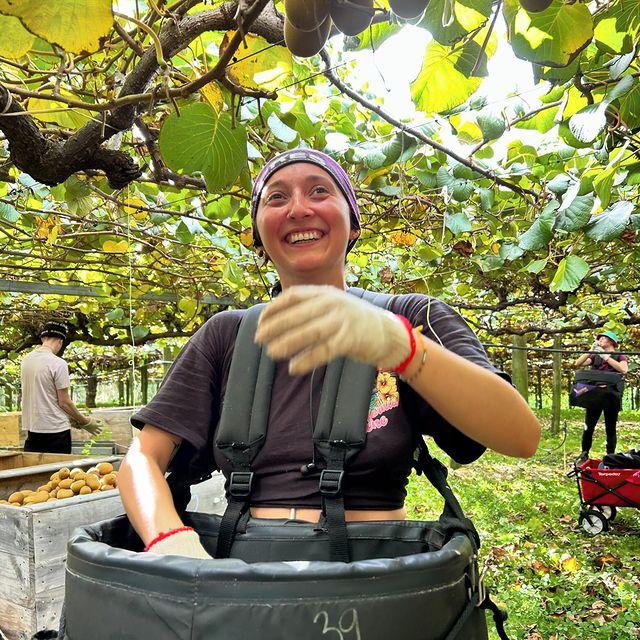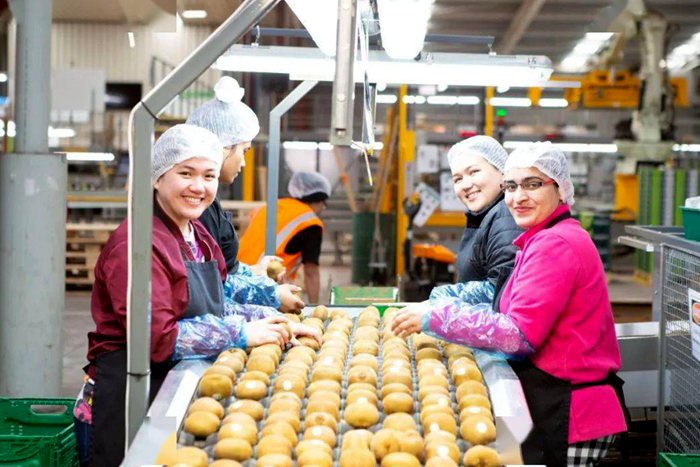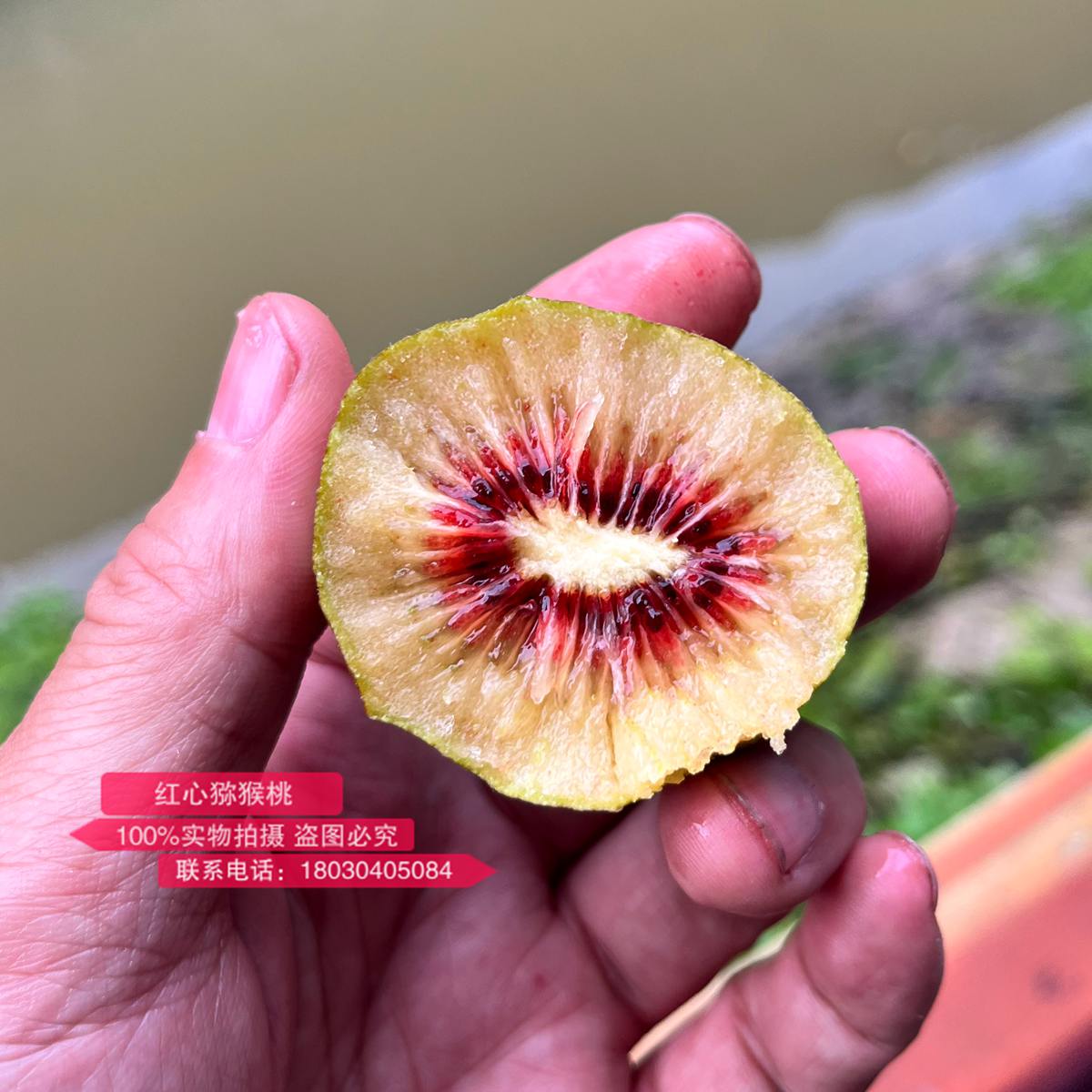Fruitometry is changing the kiwifruit industry by using unique AI for fast and precise orchard scanning. By implementing this technology, orchard owners and managers have visibility of their crops and gather information to improve yields, reduce labour costs, and make better decisions around crop management.
水果计量学通过使用独特的人工智能进行快速精确的果园扫描,正在改变猕猴桃行业。通过实施这项技术,果园所有者和管理者可以了解他们的作物,收集信息以提高产量,降低劳动力成本,并就作物管理做出更好的决策。

▲New Zealand Zespri Picking Workers
And with approximately 2800 kiwifruit growers and 3200 registered orchards in New Zealand, there’s huge potential to build efficiencies and productivity in the kiwifruit industry.
新西兰约有2800名猕猴桃种植者和3200个注册果园,猕猴桃产业在提高效率和生产力方面具有巨大潜力。

▲新西兰佳沛猕猴桃包装厂照片
The AI alternative to a manual process人工智能替代人工流程
In 2018, Chris Miller, founder and CTO of Fruitometry, used his vision technology and AI expertise to develop the Fruitometry Digital Crop Estimation (DCE) technology, a system to count kiwifruit as an alternative to the labour-intensive manual process. Joining him was Mike Ullrich, director and co-founder, who has over 25 years of experience leading high-growth global tech companies. The company has investment from Seeka and was the recipient of a Callaghan Innovation project grant.
2018年,Fruitometric的创始人兼首席技术官Chris Miller利用他的视觉技术和人工智能专业知识开发了Fruitometry数字作物估算(DCE)技术,这是一种计算猕猴桃的系统,可以替代劳动密集型的手工过程。与他同行的是董事兼联合创始人Mike Ullrich,他在领导高增长的全球科技公司方面拥有超过25年的经验。该公司获得了Seeka的投资,并获得了卡拉汉创新项目的资助。

▲yellow Kiwifruit
“Fruit growers have relied on manual counts forever,” says Chris Miller. “There was no alternative until Fruitometry offered our revolutionary service to the domestic kiwifruit market in 2019.”
克里斯·米勒说:“水果种植者一直依赖人工计数。”。“在2019年Fruitometric为国内猕猴桃市场提供革命性服务之前,别无选择。”

▲红心猕猴桃果园
He says that the primary barrier to adopting technology is a conservative mindset, with growers and managers tending to wait for others to find success with new tech before they will adopt it themselves. As Fruitometry offers radically new technology, it can present a chicken-and-egg dilemma, says Chris, so there is a focus on the value the technology brings to potential customers.
他说,采用技术的主要障碍是保守的心态,种植者和管理者倾向于等待其他人在新技术上取得成功,然后再自己采用。Chris说,由于水果计量学提供了全新的技术,它可能会出现鸡和蛋的困境,因此人们关注的是该技术为潜在客户带来的价值。

▲猕猴桃采收
“Our service fee is an investment that offers a substantial rate-of-return for growers to reduce their field costs, optimise their crop load, and improve their overall returns.”
“我们的服务费是一项投资,为种植者提供了可观的回报率,以降低他们的田间成本,优化他们的作物负荷,提高他们的整体回报。”

▲刚完成授粉的红心猕猴桃幼果
And while Fruitometry absolutely relies on AI, in the domestic market Chris says it’s the results that count, rather than a focus on the tech. “Orchard owners and managers care about their return from the dollars they spend, not the latest and greatest buzzwords.”
虽然水果计量绝对依赖于人工智能,但在国内市场,克里斯表示,重要的是结果,而不是对技术的关注。“果园主和管理者关心的是他们花的钱的回报,而不是最新、最流行的流行语。”

▲redkiwifruit
Better decisions, better outcomes for orchards and their owners
Fruitometry provides growers and managers with insights to make earlier decisions in their crop management. Within 24 hours of an orchard scan, the system generates a heatmap of the current fruit density per square metre for every row of an orchard. Scans can be done at all stages of the kiwifruit lifecycle. Scans measure winter buds to provide a check on the quality of winter pruning, shoots to assess bud burst rate for number management, flower buds to identify heavier loaded zones to inform a thinning strategy, fruitlets to help plan for thinning and to understand fruit variation across an orchard, and fruit to inform final thinning and estimate the harvest.

▲新西兰进口的宝石红红肉猕猴桃
更好的决策,为果园及其所有者带来更好的结果
水果计量学为种植者和管理者提供了在作物管理中做出早期决策的见解。在果园扫描后的24小时内,该系统会生成果园每行每平方米当前水果密度的热图。扫描可以在猕猴桃生命周期的各个阶段进行。扫描测量冬芽以检查冬季修剪的质量,测量嫩芽以评估芽爆裂率以进行数量管理,测量花蕾以确定负载较重的区域以告知疏伐策略,测量幼果以帮助计划疏伐并了解果园中的果实变化,测量果实以告知最终疏伐并估计收成。

▲zespri kiwifruit sungold
Field Units, mounted on quad bikes and ATVs, capture crop density information and orchard characteristics via a range of cameras and sensors. Data collected includes topographical data such as longitude, latitude, and altitude, and 3D image capture from multiple camera angles. For each scan thousands of photos are taken, then processed in real time using AI deep learning engine to identify buds, shoots, flowers, fruit, and canopy characteristics. To do this, Fruitometry uses an in-house processing cluster, rather than relying on slow and expensive cloud-based processing and storage services.
安装在四轮摩托车和沙滩车上的田间单元通过一系列摄像头和传感器捕捉作物密度信息和果园特征。收集的数据包括地形数据,如经度、纬度和高度,以及从多个相机角度拍摄的3D图像。每次扫描都会拍摄数千张照片,然后使用AI深度学习引擎实时处理,以识别芽、芽、花、果实和树冠特征。为此,Fruitometric使用内部处理集群,而不是依赖于缓慢而昂贵的基于云的处理和存储服务。

▲Yellow kiwifruit picking
Since 2020 Fruitometry has scanned over 3000 hectares of kiwifruit, detected 1.2 billion kiwifruit features, and processed 65 million commercial kiwifruit images. 2023 harvest accuracy results gathered in May were 96.1% on the first set of 21 data points.
自2020年以来,Fruitometry已经扫描了3000多公顷的猕猴桃,检测了12亿个猕猴桃特征,并处理了6500万张商业猕猴桃图像。5月份收集的2023年收获准确率结果在第一组21个数据点上为96.1%。

▲Red heart kiwifruit

▲新建的黄心猕猴桃果园

▲播宏猕猴桃花粉



评论